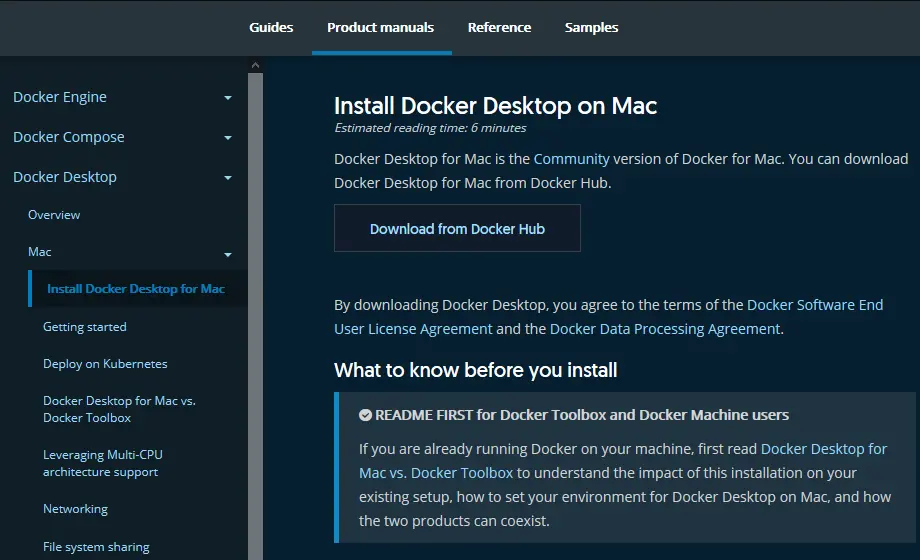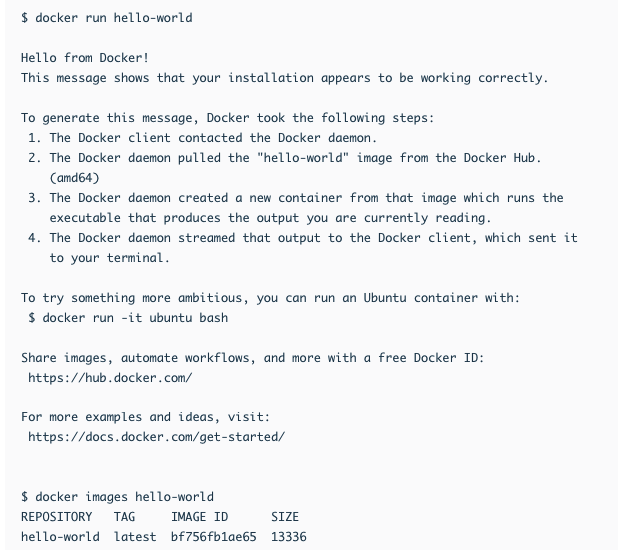Estimated reading time: 7 minutes
You can run Compose on macOS, Windows, and 64-bit Linux.
Prerequisites
Docker Compose relies on Docker Engine for any meaningful work, so make sure youhave Docker Engine installed either locally or remote, depending on your setup.
When the command is invoked, docker contacts Docker hub and downloads a docker image called ‘hello-world’. Docker then creates a new container that runs the executable script that streams the message ‘ Hello from Docker! To download or pull an image from Docker hub without running it, use the syntax: $ sudo docker pull. I have also shown you how to download Docker images from the Docker Hub registry, manage Docker images, manage Docker registries, create and use Docker containers, clone Docker containers, export Docker containers, import Docker containers, check the Docker network interfaces, and check Docker logs using the Docker app on your Synology NAS.
On desktop systems like Docker Desktop for Mac and Windows, Docker Compose isincluded as part of those desktop installs.
On Linux systems, first install theDocker Enginefor your OS as described on the Get Docker page, then come back here forinstructions on installing Compose onLinux systems.
To run Compose as a non-root user, see Manage Docker as a non-root user.
- The Linux NAS distribution (Debian based) Open Media Vault (OMV) has an UrBackup server plugin starting with OMV 3.0 in OMV-extras. Starting with OMV 5.0 use the Docker container below. ASUSTOR - ASUS NAS.
- Install Compose on Linux systems. On Linux, you can download the Docker Compose binary from the Compose repository release page on GitHub. Follow the instructions from the link, which involve running the curl command in your terminal to download the binaries. These step-by-step instructions are also included below.
Install Compose
Follow the instructions below to install Compose on Mac, Windows, Windows Server2016, or Linux systems, or find out about alternatives like using the pipPython package manager or installing Compose as a container.
Install a different version
The instructions below outline installation of the current stable release(v1.28.6) of Compose. To install a different version ofCompose, replace the given release number with the one that you want. Composereleases are also listed and available for direct download on theCompose repository release page on GitHub.To install a pre-release of Compose, refer to the install pre-release buildssection.
Install Compose on macOS
Docker Desktop for Mac includes Compose alongwith other Docker apps, so Mac users do not need to install Compose separately.For installation instructions, see Install Docker Desktop on Mac.
Install Compose on Windows desktop systems
Docker Desktop for Windows includes Composealong with other Docker apps, so most Windows users do not need toinstall Compose separately. For install instructions, see Install Docker Desktop on Windows.
If you are running the Docker daemon and client directly on MicrosoftWindows Server, follow the instructions in the Windows Server tab.
Install Compose on Windows Server
Follow these instructions if you are running the Docker daemon and client directlyon Microsoft Windows Server and want to install Docker Compose.
Start an “elevated” PowerShell (run it as administrator).Search for PowerShell, right-click, and chooseRun as administrator. When asked if you want to allow this appto make changes to your device, click Yes.
In PowerShell, since GitHub now requires TLS1.2, run the following:
Then run the following command to download the current stable release ofCompose (v1.28.6):
Note: On Windows Server 2019, you can add the Compose executable to $Env:ProgramFilesDocker. Because this directory is registered in the system PATH, you can run the docker-compose --version command on the subsequent step with no additional configuration.
Test the installation.
Install Compose on Linux systems

On Linux, you can download the Docker Compose binary from theCompose repository release page on GitHub.Follow the instructions from the link, which involve running the curl commandin your terminal to download the binaries. These step-by-step instructions arealso included below.
For alpine, the following dependency packages are needed:py-pip, python3-dev, libffi-dev, openssl-dev, gcc, libc-dev, rust, cargo and make.

Run this command to download the current stable release of Docker Compose:
To install a different version of Compose, substitute
1.28.6with the version of Compose you want to use.If you have problems installing with
curl, seeAlternative Install Options tab above.Apply executable permissions to the binary:
Note: If the command docker-compose fails after installation, check your path.You can also create a symbolic link to /usr/bin or any other directory in your path.
For example:
Optionally, install command completion for the
bashandzshshell.Test the installation.
Alternative install options
Install using pip
For alpine, the following dependency packages are needed:py-pip, python3-dev, libffi-dev, openssl-dev, gcc, libc-dev, rust, cargo, and make.
Compose can be installed frompypi using pip. If you installusing pip, we recommend that you use avirtualenv because many operatingsystems have python system packages that conflict with docker-composedependencies. See the virtualenvtutorial to getstarted.
If you are not using virtualenv,
pip version 6.0 or greater is required.
Install as a container
Compose can also be run inside a container, from a small bash script wrapper. Toinstall compose as a container run this command:
Install pre-release builds
If you’re interested in trying out a pre-release build, you can download releasecandidates from the Compose repository release page on GitHub.Follow the instructions from the link, which involves running the curl commandin your terminal to download the binaries.
Pre-releases built from the “master” branch are also available for download athttps://dl.bintray.com/docker-compose/master/.
Pre-release builds allow you to try out new features before they are released,but may be less stable.
Upgrading
If you’re upgrading from Compose 1.2 or earlier, remove ormigrate your existing containers after upgrading Compose. This is because, as ofversion 1.3, Compose uses Docker labels to keep track of containers, and yourcontainers need to be recreated to add the labels.
If Compose detects containers that were created without labels, it refusesto run, so that you don’t end up with two sets of them. If you want to keep usingyour existing containers (for example, because they have data volumes you wantto preserve), you can use Compose 1.5.x to migrate them with the followingcommand:
Alternatively, if you’re not worried about keeping them, you can remove them.Compose just creates new ones.
Uninstallation
To uninstall Docker Compose if you installed using curl:
To uninstall Docker Compose if you installed using pip:
Got a “Permission denied” error?
If you get a “Permission denied” error using either of the abovemethods, you probably do not have the proper permissions to removedocker-compose. To force the removal, prepend sudo to either of the abovecommands and run again.
Where to go next
compose, orchestration, install, installation, docker, documentationDownloads are hosted by
Changes: Changelog
Windows client
Linux Download Docker-compose

UrBackup Client 2.4.11 (x86/x64) (Vista/7/8.1/10 + Server editions)
UrBackup Client 2.4.11 (x86/x64) (Vista/7/8.1/10 + Server editions) without tray icon
UrBackup Client 2.4.11 (x64) (Vista/7/8.1/10 + Server editions) MSI installerOnly for up-to-date Windows
UrBackup Client 2.4.11 (x64) (Vista/7/8.1/10 + Server editions) MSI installer without tray iconOnly for up-to-date Windows

or with Chocolatey:
Binary Linux client (command line only; with auto-update; x86/AMD64/ARMv6+/ARM64)
Only this Linux client is auto-updated from the UrBackup server
Install with:
Docker For Linux Download
The installer includes a glibc, libstdc++ (static) x86_64 build, and completely static Android NDK builds (bionic libc, LLVM libc++) for x86, x86_64, ARMv6+, ARM64. On x86_64 it will try to use the glibc build first and fall back to the Android NDK build if that does not work.
MacOS client beta
Client source for GNU/Linux
Arch Linux
Gentoo Linux
Changes: Changelog
Image backups cannot be restored while the system is running. Therefore following live system can be used:
Download UrBackup Restore CD 2.0.2
Download UrBackup Restore CD 2.3.1 (x64)
Either burn it with any program (e.g. Nero, CDBurnerXP) or create a USB stick e.g. with Linux Live USB Creator. To restore an image boot from the CD/USB stick.
Changes: Changelog
Update Advisory: Update Advisory
Default webinterface port: 55414
Windows:
UrBackup Server 2.4.13 (x86/x64) (Vista/7/8.1/10 + Server editions)
UrBackup Server 2.4.13 (x64) (Vista/7/8.1/10 + Server editions) MSI installerOnly for up-to-date Windows
or with Chocolatey:
Install from sources:
More information: Install from sources
Debian/Ubuntu:
UrBackup Server 2.4.13 Debian stable/unstable/testing i386/amd64
UrBackup Server 2.4.13 Debian/Ubuntu stretch(with backports)/19.04 or later amd64
UrBackup Server 2.4.13 Debian/Ubuntu stretch(with backports)/19.04 or later armhf (RPi)
UrBackup Server 2.4.13 Debian/Ubuntu stretch(with backports)/19.04 or later arm64
Ubuntu:
PPA: http://launchpad.net/~uroni/+archive/urbackup
Install via e.g.
If the package is not available at the Launchpad PPA please use the OpenSuSE build service link below. The package won’t be available on the PPA for Ubuntu versions released after the UrBackup server release.
RedHat/CentOS/ScientificLinux/Fedora/SuSE/Debian/Ubuntu/Raspbian
Arch Linux:
Gentoo Linux:
FreeNAS:
QNAP NAS:
Open Media Vault:
The Linux NAS distribution (Debian based) Open Media Vault (OMV) has an UrBackup server plugin starting with OMV 3.0 in OMV-extras.Starting with OMV 5.0 use the Docker container below.
ASUSTOR - ASUS NAS

ARM
x86 (32bit)
x86-x64 (64bit)
Docker
The official container name is uroni/urbackup-server. See also the more detailed usage instructions there. It is a multi-arch docker image that works on x86/ARM 32bit/64bit.
Run UrBackup Server in a docker container via
To update docker container run:
then start via previous command.
Android
This Android application allows you to access file backups on your UrBackup Server.
